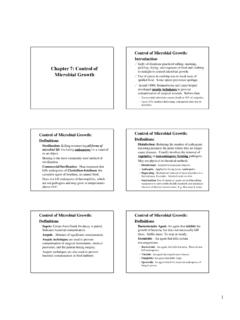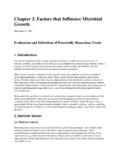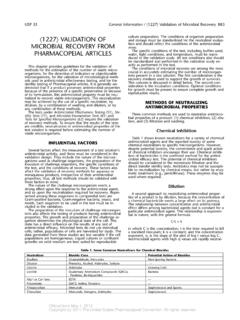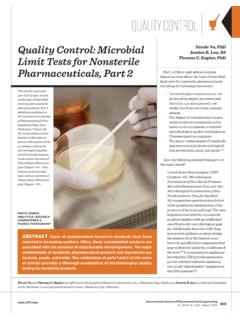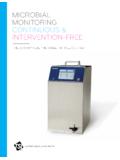Transcription of 13 - WHO | World Health Organization
1 13. Indicators of microbial water quality Nicholas J. Ashbolt, Willie Grabow and Mario Snozzi Current guidelines in the three water-related areas (drinking water, wastewater and recreational water) assess quality, in microbiological terms, by measuring indicator organisms. This chapter looks at the history and examines some of the methods used to assess the microbiological quality of water, highlighting the current limitations and also possible future developments. INTRODUCTION. Traditionally, indicator micro-organisms have been used to suggest the presence of pathogens (Berg 1978).
2 Today, however, we understand a myriad of possible reasons for indicator presence and pathogen absence, or vice versa. In short, there is no direct correlation between numbers of any indicator and enteric pathogens (Grabow 1996). To eliminate the ambiguity in the term microbial indicator', the following three groups (outlined in Table ) are now recognised: 2001 World Health Organization (WHO). Water Quality: Guidelines, Standards and Health . Edited by Lorna Fewtrell and Jamie Bartram. Published by IWA Publishing, London, UK.
3 ISBN: 1 900222 28 0. 290 Water Quality: Guidelines, Standards and Health General (process) microbial indicators, Faecal indicators (such as E. coli). Index organisms and model organisms. Table Definitions for indicator and index micro-organisms of public Health concern (see Box for definitions of microbial groups). Group Definition Process indicator A group of organisms that demonstrates the efficacy of a process, such as total heterotrophic bacteria or total coliforms for chlorine disinfection. Faecal indicator A group of organisms that indicates the presence of faecal contamination, such as the bacterial groups thermotolerant coliforms or E.
4 Coli. Hence, they only infer that pathogens may be present. Index and model A group/or species indicative of pathogen presence and behaviour organisms respectively, such as E. coli as an index for Salmonella and F-RNA. coliphages as models of human enteric viruses. A direct epidemiological approach could be used as an alternative or adjunct to the use of index micro-organisms. Yet epidemiologic methods are generally too insensitive, miss the majority of waterborne disease transmissions (Frost et al. 1996) and are clearly not preventative.
5 Nonetheless, the ideal is to validate appropriate index organisms by way of epidemiological studies. A good example is the emerging use of an enterococci guideline for recreational water quality (WHO 1998; Chapter 2 of this volume). Often epidemiologic studies fail to show any relationship to microbial indicators, due to poor design (Fleisher 1990, 1991) and/or due to the widely fluctuating ratio of pathogen(s) to faecal indicators and the varying virulence of the pathogens. The validity of any indicator system is also affected by the relative rates of removal and destruction of the indicator versus the target hazard.
6 So differences due to environmental resistance or even ability to multiply in the environment all influence their usefulness. Hence, viral, bacterial, parasitic protozoan and helminth pathogens are unlikely to all behave in the same way as a single indicator group, and certainly not in all situations. Furthermore, viruses and other pathogens are not part of the normal faecal microbiota, but are only excreted by infected individuals. Therefore, the higher the number of people contributing to sewage or faecal contamination, the more likely the presence of a range of pathogens.
7 The occurrence of specific pathogens varies further according to their seasonal occurrence (Berg and Metcalf 1978). In summary, there is no universal indicator, but a number, each with certain characteristics. Therefore, this chapter focuses on elucidating the appropriate Indicators of microbial water quality 291. uses for indicator micro-organisms with a view to their role in the management of waterborne microbial risks. To understand the current use of indicators, however, it is necessary to first understand their historical development.
8 DEVELOPMENT OF INDICATORS. The coliforms The use of bacteria as indicators of the sanitary quality of water probably dates back to 1880 when Von Fritsch described Klebsiella pneumoniae and K. rhinoscleromatis as micro-organisms characteristically found in human faeces (Geldreich 1978). In 1885, Percy and Grace Frankland started the first routine bacteriological examination of water in London, using Robert Koch's solid gelatine media to count bacteria (Hutchinson and Ridgway 1977). Also in 1885, Escherich described Bacillus coli (Escherich 1885) (renamed Escherichia coli by Castellani and Chalmers (1919)) from the faeces of breast-fed infants.
9 In 1891, the Franklands came up with the concept that organisms characteristic of sewage must be identified to provide evidence of potentially dangerous pollution (Hutchinson and Ridgway 1977). By 1893, the Wurtz method' of enumerating B. coli by direct plating of water samples on litmus lactose agar was being used by sanitary bacteriologists, using the concept of acid from lactose as a diagnostic feature. This was followed by gas production, with the introduction of the Durham tube (Durham 1893). The concept of coli- form' bacteria, those bacteria resembling B.
10 Coli, was in use in Britain in 1901. (Horrocks 1901). The colony count for bacteria in water, however, was not formally introduced until the first Report 71 (HMSO 1934). Therefore, the sanitary significance of finding various coliforms along with streptococci and C. perfringens (see Box ) was recognised by bacteriologists by the start of the twentieth century (Hutchinson and Ridgway 1977). It was not until 1905, however, that MacConkey (1905) described his now famous MacConkey's broth, which was diagnostic for lactose-fermenting bacteria tolerant of bile salts.










